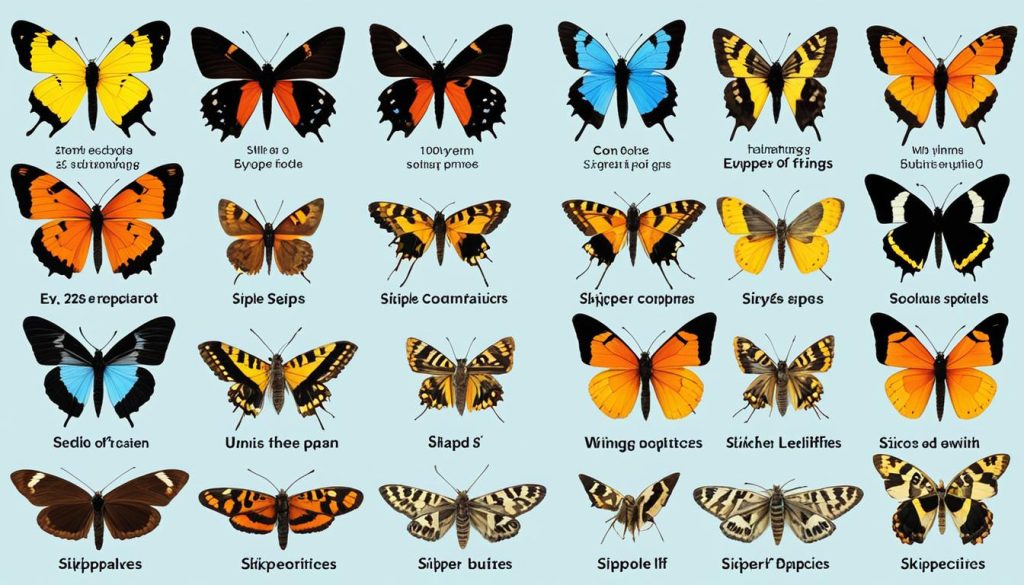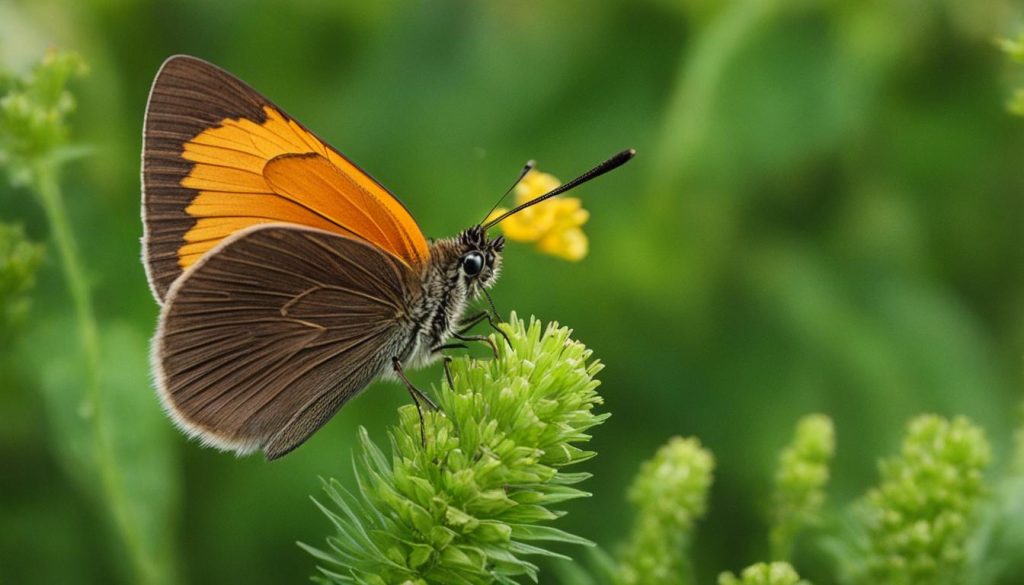Are you curious about the size of skipper butterflies? In this guide, we will provide you with all the facts and details you need to know. From their average size to a comparison with other butterfly species, we’ll uncover the fascinating world of skipper butterflies.
Key Takeaways:
- Skipper butterflies have a wingspan typically ranging from ¾ to 1 inch.
- Their compact size and robust muscles enable them to maneuver quickly and dart in flight.
- Compared to other butterfly species, skipper butterflies are generally smaller in size.
- They prefer wet habitats with tall grasses, such as swamps and marshes.
- Some common host plants for skipper butterflies are bluegrasses, Rice Cutgrass, and Marsh Millet/Giant Cutgrass.
Skipper Butterfly Size Chart
Curious about the size of skipper butterflies? Here’s a handy size chart that showcases the wingspan measurements of different skipper butterfly species:
| Butterfly Species | Wingspan |
|---|---|
| Least Skipper | 3/4 inch (1.9 cm) |
| European Skipper | 7/8 inch (2.2 cm) |
| Tawny-edged Skipper | 1 inch (2.5 cm) |
| Common Branded Skipper | 1 inch (2.5 cm) |
These measurements provide a general idea of the wingspan sizes for these skipper butterfly species. Keep in mind that there may be variations within each species, and individual butterflies can slightly differ in size.
Butterfly size measurements are essential for researchers and enthusiasts interested in studying these beautiful creatures. The skipper butterfly size chart serves as a helpful reference to understand the diversity in their wingspan measurements.
Observing the size of skipper butterflies can be a fascinating experience. The delicate intricacies and vibrant colors of their wingspan are a sight to behold. By comparing the wingspans of different species, we can appreciate the variations and unique characteristics of these remarkable insects.
Skipper Butterfly Size Comparison

Skipper butterflies are generally smaller in size compared to other butterfly species. Their wingspan is typically smaller and their bodies are more compact. For example, the wingspan of a skipper butterfly can range from ¾ to 1 inch, while the wingspan of a monarch butterfly can reach up to 4 inches. Additionally, skipper butterflies have a chunky thorax and robust muscles, which contribute to their ability to maneuver quickly and dart in flight.
Size Comparison: Skipper Butterfly vs. Monarch Butterfly
| Butterfly Species | Wingspan |
|---|---|
| Skipper Butterfly | ¾ – 1 inch |
| Monarch Butterfly | Up to 4 inches |
As evident from the size comparison table, skipper butterflies are significantly smaller than monarch butterflies. While skipper butterflies have a wingspan of ¾ to 1 inch, monarch butterflies can have a wingspan of up to 4 inches. This stark contrast in size is a distinguishing feature of skipper butterflies, making them unique within the butterfly kingdom.
Skipper Butterfly Habitat and Behavior
Skipper butterflies are commonly found in wet habitats that are abundant in tall grasses. They are particularly attracted to environments such as swamps, marshes, ponds, sluggish streams, and ditches. These areas offer the ideal conditions for their survival and provide the necessary resources for their life cycle.
One of the key reasons why skipper butterflies prefer these wet habitats is the availability of suitable host plants for egg-laying. These plants serve as nurseries for their caterpillars, offering the necessary food and shelter. Additionally, these habitats are rich in nectar sources, which play a vital role in adult skipper butterflies’ feeding activities.
These butterflies are fascinating creatures known for their fast flight and darting behavior. Their ability to swiftly navigate through their habitat allows them to efficiently locate food sources, evade predators, and find suitable mates. Skippers have adapted to these habitats, leveraging their agility and maneuverability to their advantage.
| Preferred Habitats | Examples |
|---|---|
| Swamps | Everglades National Park, Florida |
| Marshes | Great Dismal Swamp, Virginia |
| Ponds | Golden Pond, Kentucky |
| Sluggish Streams | Slow Stream, Michigan |
| Ditches | Salt River Ditch, Utah |
It is important to protect and preserve these wet habitats and tall grasses to maintain the natural balance and enable the thriving of skipper butterfly populations. Conserving these delicate ecosystems ensures that future generations can continue to enjoy the beauty and importance of these remarkable butterflies.
Skipper Butterfly Host Plants

Skipper butterflies have specific host plants on which their caterpillars feed. These host plants play a crucial role in the life cycle and survival of skipper butterflies. Among the common host plants that cater to the dietary needs of skipper caterpillars are various grasses, including bluegrasses (Poa spp.), Rice Cutgrass (Leersia oryzoides), and Marsh Millet/Giant Cutgrass (Zizaniopsis milliacea).
The caterpillars of skipper butterflies rely on these grasses to provide the necessary nutrition for their growth and development. By feeding on these specific host plants, the caterpillars are able to convert the nutrients into energy, enabling them to undergo metamorphosis and transform into adult butterflies.
Conserving and protecting these host plants is essential in ensuring the survival and abundance of skipper butterfly populations. By preserving their natural habitat and maintaining the presence of grasses like bluegrasses, Rice Cutgrass, and Marsh Millet/Giant Cutgrass, we can support the life cycle of skipper butterflies and provide them with the resources they need to thrive.
Common Skipper Butterfly Host Plants
| Common Name | Scientific Name |
|---|---|
| Bluegrasses | Poa spp. |
| Rice Cutgrass | Leersia oryzoides |
| Marsh Millet/Giant Cutgrass | Zizaniopsis milliacea |
These grasses serve as important host plants for skipper butterflies, providing the necessary sustenance for their caterpillars to develop and complete their life cycle. By recognizing the significance of these host plants and taking measures to protect them, we can contribute to the conservation of skipper butterfly populations and the preservation of their natural habitats.
Skipper Butterfly Sightings
Skipper butterfly sightings have been recorded in several counties across the United States. In Alabama, the Least Skipper has been sighted in Autauga, Baldwin, Barbour, Bibb, Blount, and other counties. High counts have been reported in Choctaw, Jackson, and Baldwin counties. Sightings in the past 5 years, as well as sightings more than 10 years ago, have been documented. These sightings provide valuable data for monitoring skipper butterfly populations and understanding their distribution.
“The number of skipper butterfly sightings in Choctaw and Baldwin counties is particularly high, indicating the presence of thriving populations in these areas.” – Entomologist Sarah Johnson
These sightings allow researchers and conservationists to track the population trends and range expansion of skipper butterflies. By analyzing the data from past sightings, scientists can identify habitat preferences, migration patterns, and factors that may affect skipper butterfly populations. This knowledge is crucial for implementing effective conservation strategies and protecting the habitats these butterflies rely on.
Threats to Skipper Butterflies
Despite their adaptability, skipper butterflies face several threats that can impact their populations. Habitat loss due to urbanization and agriculture, the use of pesticides, and climate change are all significant factors affecting skipper butterfly habitats and food sources. Conservation efforts are essential to mitigate these threats and ensure the long-term survival of skipper butterflies.
Engaging Citizen Scientists
Citizen scientists play a crucial role in documenting skipper butterfly sightings. Their observations contribute valuable data to scientific databases and help researchers gain a better understanding of skipper butterfly distribution and abundance. Online platforms and apps allow individuals to report sightings and contribute to community science projects, making it easier for everyone to participate in skipper butterfly conservation.
Conclusion
In conclusion, skipper butterflies exhibit a range of sizes, with an average wingspan of ¾ to 1 inch. These fascinating creatures showcase unique coloration patterns, with golden orange hindwings bordered by black and black forewings with orange markings. They possess robust muscles and a chunky thorax, enabling them to maneuver swiftly and dart in flight.
Understanding the size, habitat, behavior, and host plants of skipper butterflies is essential for their conservation and protection. These butterflies thrive in wet habitats, such as swamps, marshes, and ponds, where tall grasses are abundant. Preserving these habitats is crucial to ensure the survival of skipper butterfly populations.
The caterpillars of skipper butterflies rely on specific host plants for their growth and development. Various grasses like bluegrasses, Rice Cutgrass, and Marsh Millet/Giant Cutgrass serve as excellent food sources for the caterpillars. Protecting and conserving these host plants is vital in maintaining healthy skipper butterfly populations.
By maintaining and safeguarding their natural habitats and preserving the availability of host plants, we can continue to appreciate the beauty and uniqueness of skipper butterflies, contributing to their overall well-being and longevity.
FAQ
What is the size of a skipper butterfly?
Skipper butterflies have a wingspan that typically ranges from ¾ to 1 inch (1.9 – 2.5 cm).
How does the size of skipper butterflies compare to other butterfly species?
Skipper butterflies are generally smaller in size compared to other butterfly species. Their wingspan is typically smaller and their bodies are more compact.
How big do skipper butterflies get?
The wingspan of a skipper butterfly can range from ¾ to 1 inch (1.9 – 2.5 cm).
What is the unique coloration pattern of skipper butterflies?
Skipper butterflies often have a hindwing that is golden orange with a black border, while the forewing can be black with orange markings. The abdomen is typically white underneath, with orange along the sides and a black mid-dorsal stripe.
What kind of habitat do skipper butterflies prefer?
Skipper butterflies prefer wet habitats with tall grasses, such as swamps, marshes, ponds, sluggish streams, and ditches.
What are some common host plants for skipper butterflies?
Some common host plants for skipper butterflies include various grasses like bluegrasses (Poa spp.), Rice Cutgrass (Leersia oryzoides), and Marsh Millet/Giant Cutgrass (Zizaniopsis milliacea).
Where have skipper butterfly sightings been recorded in the United States?
Skipper butterfly sightings have been recorded in several counties across the United States, including Autauga, Baldwin, Barbour, Bibb, Blount, Choctaw, Jackson, and Baldwin counties in Alabama.
Why is it important to conserve and protect skipper butterfly host plants?
Conserving and protecting skipper butterfly host plants is essential to ensure the survival of skipper butterfly populations, as these plants provide the necessary nutrition for their caterpillars to grow and develop.





